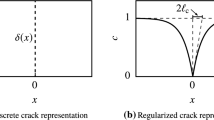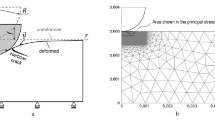Abstract
A thermodynamically consistent phase field approach for fracture including surface stresses is presented. The surface stresses which are distributed inside a finite width layer at the crack surface are introduced as a result of employing some geometrical nonlinearities, i.e., by defining energy terms per unit volume at the current time and evaluating gradient of the order parameter in the current configuration. A double-well barrier term is included in the structure of the Helmholtz free energy which allows one to use the energy terms per unit volume at the current time when introducing the surface stresses in the current approach. Thus, the surface stresses are introduced in a similar way to the interfacial stresses in phase transformations. The differences in the modeling of crack growth with considering the surface stresses and without it are discussed. It is shown how the surface stresses affect the stress fields and consequently the crack nucleation and propagation. The finite element method is utilized to solve the coupled equations of mechanics and crack phase field. It is emphasized that the surface stresses affect the driving force for both the crack nucleation and propagation by disturbing the momentum balance. Thus, a different external loading is required in the presence of the surface stresses.
Similar content being viewed by others
References
Aranson, I.S., Kalatsky, V.A., Vinokur, V.M.: Continuum field description of crack propagation. Phys. Rev. Lett. 85, 118–121 (2000)
Karma, A., Kessler, D.A., Levine, H.: Phase-field model of mode III dynamic fracture. Phys. Rev. Lett. 87, 045501 (2001)
Henry, H., Levine, H.: Dynamic instabilities of fracture under biaxial strain using a phase field model. Phys. Rev. Lett. 93, 105504 (2004)
Farrahi, G.H., Javanbakht, M., Jafarzadeh, H.: On the phase field modeling of crack growth and analytical treatment on the parameters. Contin. Mech. Thermodyn. (2018). https://doi.org/10.1007/s00161-018-0685-z
Levitas, V.I., Jafarzadeh, H., Farrahi, G.H., Javanbakht, M.: Thermodynamically consistent and scale-dependent phase field approach for crack propagation allowing for surface stresses. Int. J. Plast. 111, 1–35 (2018). https://doi.org/10.1016/j.ijplas.2018.07.005
Levitas, V.I., Javanbakht, M.: Phase transformations in nanograin materials under high pressure and plastic shear: nanoscale mechanisms. Nanoscale 6, 162–166 (2014)
Javanbakht, M., Barati, E.: Martensitic phase transformations in shape memory alloy: phase field modeling with surface tension effect. Comput. Mater. Sci. 115, 137–144 (2016). https://doi.org/10.1016/j.commatsci.2015.10.037
Mirzakhani, S., Javanbakht, M.: Phase field-elasticity analysis of austenite-martensite phase transformation at the nanoscale: finite element modeling. Comput. Mater. Sci. 154, 41–52 (2018). https://doi.org/10.1016/j.commatsci.2018.07.034
Javanbakht, M., Levitas, V.I.: Phase field approach to dislocation evolution at large strains: computational aspects. Int. J. Solids Struct. 82, 95–110 (2016)
Javanbakht, M., Levitas, V.I.: Interaction between phase transformations and dislocations at the nanoscale. Part 2: phase field simulation examples. J. Mech. Phys. Solids 82, 164–185 (2015)
Levitas, V.I., Javanbakht, M.: Interaction between phase transformations and dislocations at the nanoscale. Part 1: general phase field approach. J. Mech. Phys. Solids 82, 287–319 (2015). https://doi.org/10.1016/j.jmps.2015.05.005
Levitas, V.I., Javanbakht, M.: Surface tension and energy in multivariant martensitic transformations: phase-field theory, simulations, and model of coherent interface. Phys. Rev. Lett. 105, 165701 (2010)
Levitas, V.I., Javanbakht, M.: Surface-induced phase transformations: multiple scale and mechanics effects and morphological transitions. Phys. Rev. Lett. 107, 175701 (2011)
Levitas, V.I., Javanbakht, M.: Phase field approach to interaction of phase transformation and dislocation evolution. Appl. Phys. Lett. 102, 251904 (2013)
Levitas, V.I., Javanbakht, M.: Thermodynamically consistent phase field approach to dislocation evolution at small and large strains. J. Mech. Phys. Solids 82, 345–366 (2015). https://doi.org/10.1016/j.jmps.2015.05.009
Javanbakht, M., Levitas, V.I.: Phase field simulations of plastic strain-induced phase transformations under high pressure and large shear. Phys. Rev. B 94, 214104 (2016)
Javanbakht, M., Levitas, V.I.: Nanoscale mechanisms for high-pressure mechanochemistry: a phase field study. J. Mater. Sci. 53(19), 13343–13363 (2018)
Rinaldi, A., Placidi, L.: A microscale second gradient approximation of the damage parameter of quasi-brittle heterogeneous lattices. ZAMM J. Appl. Math. Mech. 94, 862–877 (2014)
Dell’Isola, F., Andreaus, U., Placidi, L.: At the origins and in the vanguard of peridynamics, non-local and higher-gradient continuum mechanics: an underestimated and still topical contribution of Gabrio Piola. Math. Mech. Solids 20, 887–928 (2015)
Dell’Isola, F., Seppecher, P., Della Corte, A.: The postulations á la D’Alembert and á la Cauchy for higher gradient continuum theories are equivalent: a review of existing results. Proc. R. Soc. A 471, 20150415 (2015)
Placidi, L.: A variational approach for a nonlinear 1-dimensional second gradient continuum damage model. Contin. Mech. Thermodyn. 27, 623–638 (2015)
Levitas, V.I.: Thermodynamically consistent phase field approach to phase transformations with interface stresses. Acta Mater. 61, 4305–4319 (2013). https://doi.org/10.1016/j.actamat.2013.03.034
Levitas, V.I.: Phase field approach to martensitic phase transformations with large strains and interface stresses. J. Mech. Phys. Solids 70, 154–189 (2014)
Liu, T., Long, R., Hui, C.-Y.: The energy release rate of a pressurized crack in soft elastic materials: effects of surface tension and large deformation. Soft Matter 10, 7723–7729 (2014). https://doi.org/10.1039/C4SM01129E
Chuang, T.J.: Effect of surface tension on the toughness of glass. J. Am. Ceram. Soc. 70, 160–164 (1987)
Dell’Isola, F., Corte, A.D., Giorgio, I.: Higher-gradient continua: the legacy of Piola, Mindlin, Sedov and Toupin and some future research perspectives. Math. Mech. Solids 22, 852–872 (2017)
Placidi, L., Barchiesi, E.: Energy approach to brittle fracture in strain-gradient modelling. Proc. R. Soc. A 474, 20170878 (2018)
Placidi, L., Misra, A., Barchiesi, E.: Two-dimensional strain gradient damage modeling: a variational approach. Zeitschrift für angewandte Mathematik und Physik 69, 56 (2018)
Placidi, L., Misra, A., Barchiesi, E.: Simulation results for damage with evolving microstructure and growing strain gradient moduli. Contin. Mech. Thermodyn. (2018). https://doi.org/10.1007/s00161-018-0693-z
Porter, D.A., Easterling, K.E., Sherif, M.: Phase Transformations in Metals and Alloys. (Revised Reprint). CRC Press, Boca Raton (2009)
Cuomo, M.: Continuum damage model for strain gradient materials with applications to 1D examples. Contin. Mech. Thermodyn. (2018). https://doi.org/10.1007/s00161-018-0698-7
Cuomo, M.: Continuum model of microstructure induced softening for strain gradient materials. Math. Mech. Solids (2018). https://doi.org/10.1177/1081286518755845
Author information
Authors and Affiliations
Corresponding author
Additional information
Communicated by Francesco dell’Isola.
Publisher's Note
Springer Nature remains neutral with regard to jurisdictional claims in published maps and institutional affiliations.
Rights and permissions
About this article
Cite this article
Jafarzadeh, H., Farrahi, G.H. & Javanbakht, M. Phase field modeling of crack growth with double-well potential including surface effects. Continuum Mech. Thermodyn. 32, 913–925 (2020). https://doi.org/10.1007/s00161-019-00775-1
Received:
Accepted:
Published:
Issue Date:
DOI: https://doi.org/10.1007/s00161-019-00775-1




